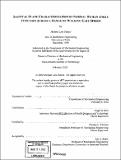| dc.contributor.advisor | Hugh M. Herr and Woodie C. Flowers. | en_US |
| dc.contributor.author | Palmer, Michael Lars, 1974- | en_US |
| dc.contributor.other | Massachusetts Institute of Technology. Dept. of Mechanical Engineering. | en_US |
| dc.date.accessioned | 2005-05-19T14:38:51Z | |
| dc.date.available | 2005-05-19T14:38:51Z | |
| dc.date.copyright | 2002 | en_US |
| dc.date.issued | 2002 | en_US |
| dc.identifier.uri | http://hdl.handle.net/1721.1/16802 | |
| dc.description | Thesis (S.M.)--Massachusetts Institute of Technology, Dept. of Mechanical Engineering, 2002. | en_US |
| dc.description | Includes bibliographical references (leaves 69-71). | en_US |
| dc.description | This electronic version was submitted by the student author. The certified thesis is available in the Institute Archives and Special Collections. | en_US |
| dc.description.abstract | The function of the human ankle during the stance phase of walking is characterized in terms of simple mechanical elements that can reproduce the sagittal plane dynamics of a normal ankle. The dynamics of the ankle are taken from the analysis of the slow, normal, and fast gait of 10 healthy young subjects. Thus gait-speed-dependent changes in ankle function are evaluated. Characterization of the ankle is divided into three phases of gait: controlled plantartlexion, controlled dorsitlexion, and powered plantarflexion. Ankle function during controlled plantarflexion is characterized by a linear, torsional spring. The work done by the spring increases with gait speed, and while gait speed is constant, the work is kept constant by modulating the stiffness from stride to stride. Ankle function during controlled dorsiflexion is characterized by a nonlinear, torsional spring that becomes more stiff as it rotates. Ankle function during powered plantarflexion is characterized by a torque actuator that assists the nonlinear, torsional spring in plantartlexing the foot. The combined work done by the actuator and spring increases with gait speed as does the portion of that work that is done by the torque actuator. | en_US |
| dc.description.statementofresponsibility | by Michael Lars Palmer. | en_US |
| dc.format.extent | 71 leaves | en_US |
| dc.format.extent | 2780026 bytes | |
| dc.format.extent | 4903132 bytes | |
| dc.format.mimetype | application/pdf | |
| dc.format.mimetype | application/pdf | |
| dc.language.iso | eng | en_US |
| dc.publisher | Massachusetts Institute of Technology | en_US |
| dc.rights | M.I.T. theses are protected by copyright. They may be viewed from this source for any purpose, but reproduction or distribution in any format is prohibited without written permission. See provided URL for inquiries about permission. | en_US |
| dc.rights.uri | http://dspace.mit.edu/handle/1721.1/7582 | |
| dc.subject | Mechanical Engineering. | en_US |
| dc.title | Sagittal plane characterization of normal human ankle function across a range of walking gait speeds | en_US |
| dc.type | Thesis | en_US |
| dc.description.degree | S.M. | en_US |
| dc.contributor.department | Massachusetts Institute of Technology. Department of Mechanical Engineering | |
| dc.identifier.oclc | 50504711 | en_US |
